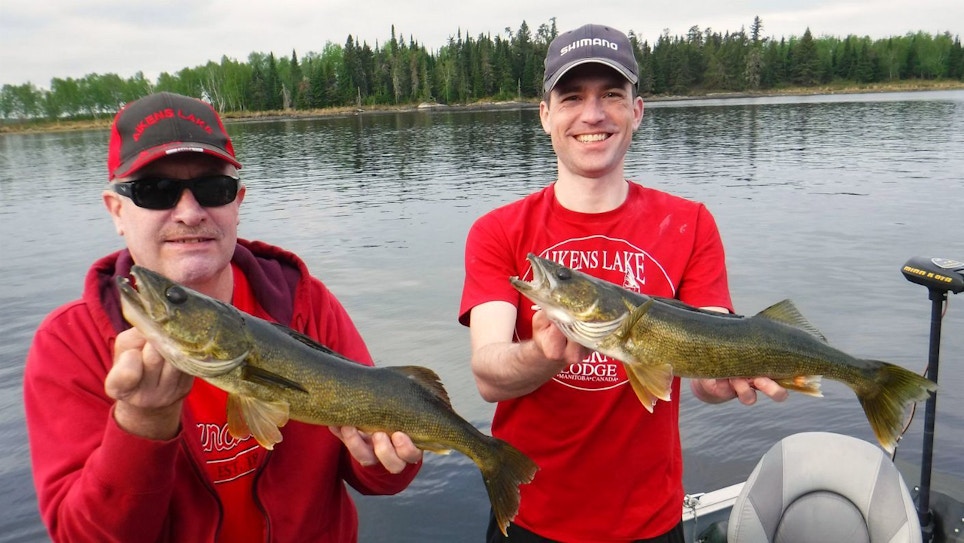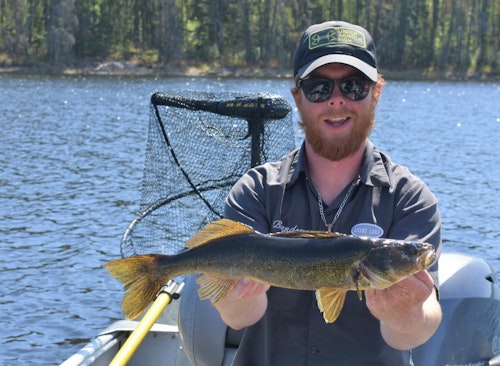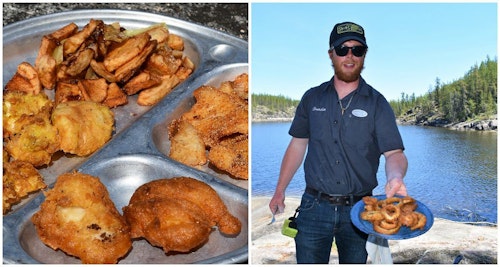Brenden Windsor has been catching fish since he was 2 and cooking them since he was 12, so I figured I was in for a treat during my day with the second-year pro-staff guide at Aikens Lake Wilderness Lodge. I was right.
Walleye were our target on a sunny, 75-degree day in late May at the luxury, family-run fly-in fishing resort near Winnipeg, Manitoba. Back home in St. Paul, Minnesota, I’m a simple fisherman when it comes to walleyes. Jig and a minnow. Maybe a crawler.
Windsor — the walking definition of a fishhead — is about as skilled as they come, so I was eager to learn from him. He didn’t disappoint. He had my father and I bottom bouncing in the flats with gold blades and brown/purple plastic worms, and the results were immediately effective.
Two minutes into our morning, my dad landed a fat 22-inch walleye. Thirty seconds later, I added a 17-incher that went straight into the live well. Aikens has a thoughtful catch-and-release policy (all fish go right back into the lake, except for a couple smaller walleyes under 19 inches for shore lunch) that has directly contributed to the lake’s oversized walleye population. An insanely high percentage of the lake’s primary species are in the mid 20-inch range.
Our quick start proved not to be a fluke. We continued to haul in 21- to 25-inch walleyes at a decent clip — not one fish immediately followed by another all the time, but a solid, steady pace throughout the morning. As a live bait guy, I have to admit I was surprised by our success with the plastic worm. But Windsor has his logic, and it clearly works.
Specifically, he prefers a Cabela’s 6-inch Finesse Worm, Color “PB&J” cut in half, on a single-hook crawler rig with a silver blade and five red beads.

Windsor instructed us to let line out until we felt bottom, then keep the line slack for either one long or two short sweeps of the rod to release just enough additional line for the bottom bouncer to run true, but not any excess line — a common mistake he cautioned us to avoid.
With this approach, walleyes were triggered by the flash of the blade, the visual of the plastic and the slight movement of the worm, so a real worm was not necessarily. The benefit became evident when we started catching perch.
“The thing about nightcrawlers is nearly anything will eat them,” Windsor said. “That’s great, but a lot of walleye fisheries have high populations of perch or other panfish that often congregate in the same spots as walleyes, and a dangling nightcrawler can be like a magnet to a perch. You start getting tons of hits, and when you miss bites with a crawler, you’re often reeling in to check your bait. That’s wasted time.”
The beauty of the plastic worm, Windsor revealed, is not only the fish it will attract, but the time it will save.
“With a plastic worm, if you miss a hit you’re confident the bait’s still there, so you’re not reeling in to check all the time. That’s more time with your bait in the strike zone,” Windsor said. “Even if you’re reeling in a small fish and it flips off boat-side, you don’t have to re-bait — as soon as the fish is off you’re back down in the water.”
It not only saves you time, but essentially increases the amount of water you’re able to fish with your bait in the water. Windsor recommends a modest speed for your backtroll when bottom bouncing, changing up the speed as needed.
On this day, experimenting with different speeds was not required because we were hooked up more often than not, also catching 15 northern pike in addition to our walleyes. The only “challenge,” if you will, was catching enough “small” walleyes under 19 inches to eat for lunch.
Talk about a first-class problem. Aikens is not cheap, but sometimes you get what you pay for.

A handful of clouds crawled across the blue sky at the noon hour, and we broke for lunch at a scenic island that is one of Windsor’s favorite spots to display his culinary skills. To be clear, those skills are vast. He prepared our fish three different mouth-watering ways — and offered us additional options — and we savored each bite of our beer-battered, mustard-fry, and Aikens Cajun spice walleyes. For an extra treat, Windsor also made ridiculously tasty onion rings for us.
Every shore lunch walleye was caught on the 6-inch plastic worm, a lure I’ve used extensively for bass but never considered for walleyes. Through the years I’ve learned the best fishing guides don’t simply put you on fish, they teach something you can use later on your home waters. During this day, my eyes were opened to a simple and effective technique for catching walleyes without the hassle or expense of live bait.

Sidebar: A Guide’s Life
During the offseason away from Aikens, Brenden Windsor hits the hard water (ice) back home and further hones both his fishing and cooking talents with winter crappies as his favorite table fare. As a kid, Windsor would go fishing all day and experiment with different ways of preparing fish for his family’s dinner. Today, a day off work is often similarly spent with Windsor targeting trophy fish across eastern Manitoba.
Windsor has more than 200 Manitoba Master Angler fish across a dozen different species to his name, and it’s not a stretch to say he is one of the best ice fishermen under age 25 in Manitoba. On the open-water front, Windsor once caught 26 Master Angler catfish by himself in a single night on Manitoba’s Red River.
These days, as much as Windsor loves catching all sorts of trophy fish, his favorite passion is helping others do the same.
“Being a guide is a great job. The level of excitement and appreciation from someone you guide is amazing,” said Windsor. “I feel more satisfaction guiding a trophy than catching one.”










